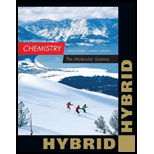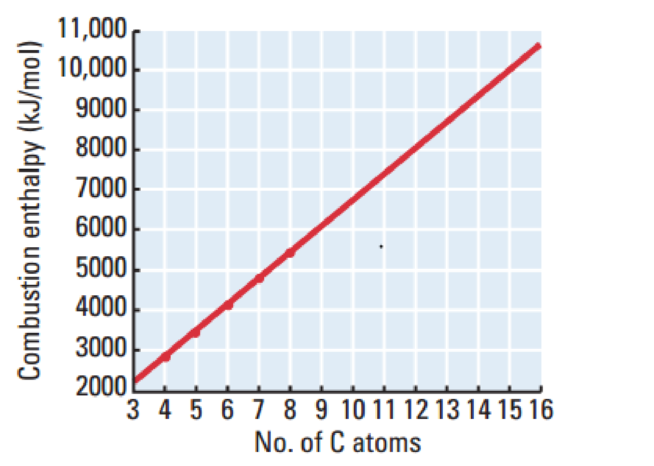
Concept explainers
(a)
Interpretation:
The enthalpy of combustion of propane, nonane, and hexadecane has to be predicted with help of graphical method.
Concept Introduction:
The amount of energy which is produced or absorbed during the reaction is the enthalpy change of a
(a)
Answer to Problem 124QRT
The enthalpy of combustion of propane
Explanation of Solution
The given data table is shown below.
| Hydrocarbon | Formula | Enthalpy if combustion (kJ/mol) |
| Butane | ||
| Pentane | ||
| Hexane | ||
| Heptane | ||
| Octane |
The graph has been plotted between enthalpy of combustion on the

Figure 1
When the number of carbon atom is
Therefore, the enthalpy of combustion of propane
When the number of carbon atom is
Therefore, the enthalpy of combustion of nonane
When the number of carbon atom is
Therefore, the enthalpy of combustion of hexadecane
(b)
Interpretation:
The reason as to why the slope of graph enthalpy of combustion on the
Concept Introduction:
Refer to part (a).
(b)
Answer to Problem 124QRT
The graph has positive slope because bond enengy increases as the number of carbon increases.
Explanation of Solution
The given data table is shown below.
| Hydrocarbon | Formula | Enthalpy if combustion (kJ/mol) |
| Butane | ||
| Pentane | ||
| Hexane | ||
| Heptane | ||
| Octane |
The graph has been plotted between enthalpy of combustion on the

Figure 1
This graph has positive value.
The combustion of hydrocarbons involves breaking of
The bond enthalpy for
The bond enthalpy for
The number of bonds
Want to see more full solutions like this?
Chapter 10 Solutions
Chemistry: The Molecular Science, Hybrid Edition (with OWLv2 24-Months Printed Access Card)
- Summarize the nomenclature rules for alkanes, alkenes, alkynes, and aromatic compounds. Correct the following false statements regarding nomenclature of hydrocarbons. a. The root name for a hydrocarbon is based on the shortest continuous chain of carbon atoms. b. The suffix used to name all hydrocarbons is -ane. c. Substituent groups are numbered so as to give the largest numbers possible. d. No number is required to indicate the positions of double or triple bonds in alkenes and alkynes. e. Substituent groups get the lowest number possible in alkenes and alkynes. f. The ortho- term in aromatic hydrocarbons indicates the presence of two substituent groups bonded to carbon- 1 and carbon-3 in benzene.arrow_forwardEthanol, C2H6O, is most often blended with gasoline - usually as a 10 percent mix - to create a fuel called gasohol. Ethanol is a renewable resource and ethanol-blended fuels, like gasohol, appear to burn more efficiently in combustion engines. The heat of combustion of ethanol is 326.7 kcal/mol.The heat of combustion of 2-methylhexane, C7H16, is 1.150×103 kcal/mol. How much energy is released during the complete combustion of 446 grams of 2-methylhexane ?________ kcal Assuming the same efficiency, would 446 grams of ethanol provide more, less, or the same amount of energy as 446 grams of 2-methylhexane? _________. (more, less, or the same amount)arrow_forwardEthanol, C2H6O, is most often blended with gasoline - usually as a 10 percent mix - to create a fuel called gasohol. Ethanol is a renewable resource and ethanol-blended fuels, like gasohol, appear to burn more efficiently in combustion engines. The heat of combustion of ethanol is 326.7 kcal/mol.The heat of combustion of 2-methylhexane, C7H16, is 1.150×103 kcal/mol. How much energy is released during the complete combustion of 452 grams of 2-methylhexane ?Assuming the same efficiency, would 452 grams of ethanol provide more, less, or the same amount of energy as 452 grams of 2-methylhexane?arrow_forward
- compare and contrats the physical and chemical properties of open-chain versus closed-chain hydrocarbonsarrow_forwardHow many grams of oxygen are needed for the complete combustion of 52.0 g of acetylene?arrow_forwardCalculate the enthalpy of benzene from its enthalpy of combustion and the enthalpy of combustion of cyclohexanearrow_forward
- Chemistry: Matter and ChangeChemistryISBN:9780078746376Author:Dinah Zike, Laurel Dingrando, Nicholas Hainen, Cheryl WistromPublisher:Glencoe/McGraw-Hill School Pub Co
 Chemistry: The Molecular ScienceChemistryISBN:9781285199047Author:John W. Moore, Conrad L. StanitskiPublisher:Cengage Learning
Chemistry: The Molecular ScienceChemistryISBN:9781285199047Author:John W. Moore, Conrad L. StanitskiPublisher:Cengage Learning  ChemistryChemistryISBN:9781305957404Author:Steven S. Zumdahl, Susan A. Zumdahl, Donald J. DeCostePublisher:Cengage Learning
ChemistryChemistryISBN:9781305957404Author:Steven S. Zumdahl, Susan A. Zumdahl, Donald J. DeCostePublisher:Cengage Learning Chemistry: An Atoms First ApproachChemistryISBN:9781305079243Author:Steven S. Zumdahl, Susan A. ZumdahlPublisher:Cengage Learning
Chemistry: An Atoms First ApproachChemistryISBN:9781305079243Author:Steven S. Zumdahl, Susan A. ZumdahlPublisher:Cengage Learning





